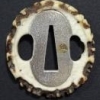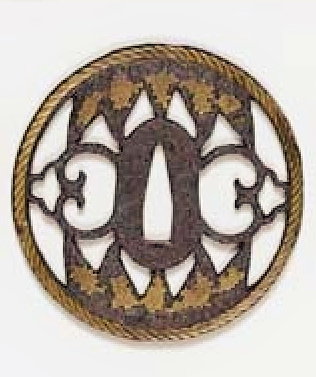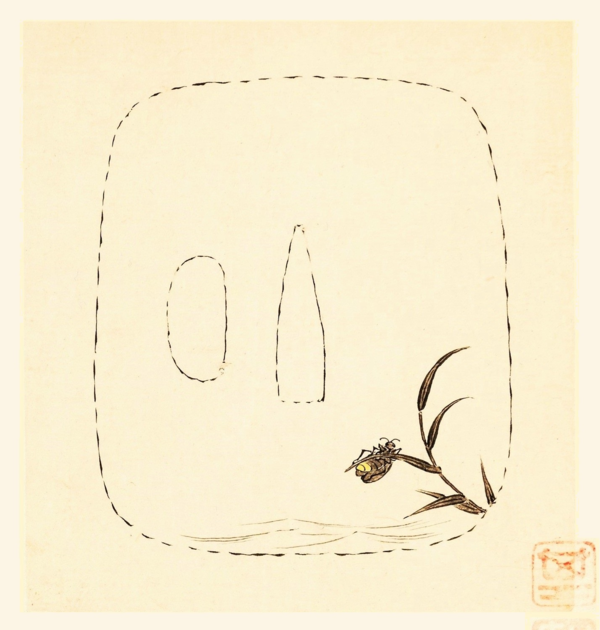-
Posts
3,412 -
Joined
-
Last visited
-
Days Won
90
Everything posted by Spartancrest
-
This copy [repro] has just sold on auction - there are a dozen versions of it about, this is one of the 'better' ones but still fake. The ura side always lets them down, probably late Meiji early twentieth Century - hard to tell some are still being made! https://www.jauce.com/auction/d498881440 40 bids sold for 35,500 yen.
-
I see Barnes & Noble have the matte book listed https://www.barnesandnoble.com/w/album-of-designs-for-metal-carving-ranzan-tsuneyuki/1138546816 They have it listed with free shipping. I am unsure if this is USD.
-

Trying out my fake detection skills - Tsuba
Spartancrest replied to Infinite_Wisdumb's topic in Tosogu
Jesse You will also note the over run of metal into the nakago-ana. A lot of fast production fakes have this, as well there is a tendency for a V shaped bottom of the nakago-ana rather than a straight line. Like George has said the 'mei' is wrong it is rather wide and not like it should be if cut with a chisel. Fakes can even have sekigane simulated by an outline marked by different colour, not a cutout and filled with copper [ this is not present of course on your example. -
Nambu tekki tsuba with a purpose! These cast iron plates would serve very well as 'sizzle' plates, I have a set myself [always five in a set] They are on the small size, like a saucer so you won't fit a big meal on them ! They turn up from time to time at reasonably cheap prices - the catch these days is the weight and shipping cost! https://www.jauce.com/auction/f486771757
-
Hi Tomas The 'Cloud Dragon' guards you have are perhaps the most common examples found, I believe they were made for practice swords or Mozo-to. Because your guards are cast you could first try simply boiling them in water for a while, if they don't 'clean up' you can try boiling in vinegar for five minutes, rinse in water and use a soft cotton cloth to dry. You will lose any patina but that is not really a factor in cast reproductions.
-

2020 wasn't all that bad... a recap of tsuba acquisitions
Spartancrest replied to Oshy's topic in Tosogu
Hi Mauro, I have seen a few examples of your no. 8. One sold back on 28th March 2006, sale 1638 by Christies, formerly in the Metropolitan Museum collection. The picture quality is not great. Described as " Iron openwork ishime-ji tsuba with brass overlays on stylized foliage and brass rope rim" [ it and two dissimilar guards sold for $5,400 USD.] Ps. Remind me not to donate my collection to the Met - they will sell it off! -
I sent Artemis a message about selling "authenticated" Chinese fakes. To their credit they have replied and the item has been removed from the auction. "If you see something - say something" If only eBay and others were as responsible! Artemis Gallery Ancient Art Sydelle Rubin-Dienstfrey Ph.D. Art History Mgr. Research & Writing Mgr. Fine Art Hello Dale, Thank you for this input. We will investigate this ASAP. With much appreciation, Sydelle
-
Yas I saw the same on Jauce. It is a very bad sign. I wonder where and how they obtained so many - from Christies themselves or a returned consignment? I agree with Barry it is a very bad practice selling empty boxes with hakonaki [especially with a Christies consignment sticker] The unscrupulous will load them up with repro's or fakes and demand big prices from the unwary. This is a similar practice as selling old Shinsa papers with no items, it is open to substitutions. I note the boxes have substitute linings and no cushions - what happened there? Also they all appear relatively new, they haven't been in some collection very long - ?
-
Well we have hit rock bottom with this little item - https://www.jauce.com/auction/524113488 The attached statement reads very funny. State Slightly scratched and dirty ★ ☆ Fake Important Cultural Property Chidori Chidori Figure Inferior Goods Bending Tsuba ★ ☆ Inferior Important Cultural Property Chidori Chidori Figure (Inferior Goods 1 ???? Yen) is exhibited .. Refer to the photo. Please make your own judgment. Does not include shooting jigs. Aluminum molded products Partially wooden or copper- covered rings Inferior goods have been sold. I bought it from a major company in Osaka . It is a very rare bending brim. Be careful of the staggered figure of the eastern rain, which is an important cultural property of modern inferior goods . Please do not buy this product ・ Purchased and received a bad evaluation ・ Distributor name: I want to keep the morals of one of the commandments." I have to believe the seller is having a shot at the original seller who sold him the piece, he really should name and shame! What he may have been trying to buy [if I have put the jigsaw back in place ] is this design, taken from "Japanese Swords" by Nobuo Ogasawara - the design appears in other publications [and I have always wanted one!]
-
https://www.ebay.com/itm/Katana-Tsuba-Crab-Basket-Sword-Equipment-Japanese-Sword-Samurai-Antique-M638/284092202276?hash=item422536fd24:g:twoAAOSwr7RfvKtN https://www.ebay.com/itm/Katana-sword-guard-crab-basket-sword-equipment-Japanese-sword-prop-tsuba-h-292/274584701363?hash=item3fee8609b3:g:k9wAAOSwF2tfuPOy Two ebay sites with the same junk - right down to the same pictures used but by two sellers. https://www.jauce.com/auction/k493388709 Japanese, Jauce site. Also the same stock pictures used. No imagination. buyer beware!
-
Big name auction house pushing junk - https://www.invaluable.com/auction-lot/Japanese-edo-gilded-silvered-brass-tsuba-crab-46-c-3684f009c4 The last line of the description is very telling - 'authenticity' - you must be joking! Description East Asia, Japan, Edo Period, ca. 1603 to 1868 CE. An unusual basket-shaped gilded brass and silvered brass tsuba (hand guard) traditionally used with Japanese swords. The upper section features a gilt brass crab crawling over the basket, and the body of the tsuba presents an openwork brass basketweave design with a central blade opening (Nakago-ana) and a silvered brass rim. The crab is likely a reference the legend of Heikegani, the so-called samurai ghost crab. Heikegani is a species of crab that is native to Japan and possesses a pattern that is reminiscent of a human face. Given this, the Heikegani crab is thought to contain the souls of Heike samurai warriors who were killed during the Battle of Dan-no-ura in 1185 CE - an especially significant event in Japanese history that established the first shogunate. Size: 3" W x 3.4" H (7.6 cm x 8.6 cm) A tsuba is the hand guard of a traditional Japanese sword, usually a katana or tachi. Its primary purposes are to balance the sword, prevent one's hand from sliding down the blade and, as a last resort, as a block against an opponent's thrust or slash. However, as time and skills developed, the tsuba evolved into an artistic item and symbol representing wealth, prestige, or skills as a swordsman. Early tsuba, known as neri tsuba, were made of leather encased in an iron or wooden frame which was occasionally lacquered for strength and stability. Provenance: private southern California, USA collection, acquired before 2000. All items legal to buy/sell under U.S. Statute covering cultural patrimony Code 2600, CHAPTER 14, and are guaranteed to be as described or your money back. A Certificate of Authenticity will accompany all winning bids.
-
Jesse. The tang hole [nakago-ana] is usually the giveaway on fakes, the poorer Chinese ones often have an ambiguous shaped hole that can almost be used upside down. With the cost of copper being up, most fakes are made of cheaper alloys. The colour [iroe] is also a giveaway, most Japanese tsuba have a subdued colouring not garish [ there are exceptions] It is a big learning curve and I doubt there is anyone on NMB who haven't bought a fake at sometime or other. With modern techniques many fakes are getting better and better, so we all need to look out! Brian is correct, the more you see the more you know - I am sure he can scroll through an auction site and automatically dismiss many of the fakes almost instantly. Me, I often need a second glance! There is another Chinese made fake here - https://www.ebay.com.au/itm/Tsuba-Sword-Braces-Japanese-Swords-Flange-Weight-156/203232505876?hash=item2f5199f014:g:0K0AAOSwdytf6qmh - Chinese fake being sold from Japan, this is increasingly the case. You can spot it is fake very easily if you notice the hitsu-ana, it has casting spills into what should be clear space.
-
The design book 'Chosen Gafu' has just been listed on Amazon - I am amazed that the cost is only three dollars US. more expensive than what I have to pay [soft cover].The cost of shipping is a major factor and no doubt varies from country to country. Amazon's Free shipping is a big incentive for those living in the US. , I will keep checking for 'deals' from Blurb and let you know when they occur. https://www.amazon.com.au/s?k=chosen+gafu+book&i=stripbooks&dc&ref=a9_asc_1 https://www.amazon.com/Album-Designs-Metal-Carving-Chōsen/dp/1034179020/ref=tmm_pap_swatch_0?_encoding=UTF8&qid=1610007658&sr=1-1 Checking back on Amazon US. there is a twenty dollar shipping component for overseas buyers - which does change things. If you want a copy of the book at cost straight from the printer Blurb. [ I am not making any money from this ] I would suggest you give me a personal message with your postal address and I can give you the cheapest option, here in Australia I am stuck with priority =AUD $48.99 or express =AUD $32.99 postage, yet if I ordered for say a Canadian address shipping is only AUD $15.99 ? And a US. address from as little as AUD $5.99 Does that seem fair? These prices [as in the attachment ] are for the matte book softcover only. Hard cover is slightly more. A lot cheaper than through the book dealers. Hard cover Items US $22.79 Shipping US $3.99 Tax US $1.42 Total US $28.20
-
Yas - just for a laugh - https://www.jauce.com/auction/o449060436 I think price has too many zero's, needs to be 12 yen.
-
Bob that is a great idea actually, I should have included some ruled pages for added notes, I will keep it in mind for any other books.
-
Fujiwara-kyo was located in Yamato province (present-day Kashihara in Nara Prefecture) it was burnt to the ground in 711 - I don't think that is it. Fujiwara (藤原町, Fujiwara-chō) was a town located in Inabe District, Mie Prefecture, Japan. On December 1, 2003, Fujiwara, along with the towns of Inabe (former), Hokusei and Daian (all from Inabe District), was merged to create the city of Inabe. There is also mention of the Fujiwara clan - could that be a reference to look into?
-
Yas I do like the Mokume, I am sure many would pay that - Not in my price range though. - 586 is it silver and gold? I don't recall seeing clouds with nanako before, do you think it is Japanese buyers or Westerners?
-
Bruno that is a fantastic dream, I do hope it can happen sometime not too far away. I think Google image was supposed to do something like that, but it fails terribly, how many people have tried 'dropping' an image of a tsuba and getting picture feedback of belt buckles, badges or buttons! A picture data base was the aim of the Met books and the design book for that matter - it is a technical problem to index images in a useful way - goodness we humans have enough trouble comparing images by eye as it is ! Peter, thank you, my book sales keep me in the poverty I have grown accustom to. [ It is a hobby that keeps me home, and not down the pub - which is convenient because I don't drink anyway - win win!]
-
Thank you Brian, you are correct, even just compiling what I have, takes time [lots] adding full information even if accurate would take years - why do you think the Museums don't do it very well, because they can't afford the time. Seriously I do wish others [who have the time] would put pen to paper and do their own books, think of all that information in members heads that just disappears when people pass on. What a waste. Believe me it really isn't that hard - just start! [ I know it is now 'finger to keyboard' but it doesn't have the same ring to it. ] I did check and in order to get better print quality I am constrained by the number of pages that Blurb and others will print in one volume, so that I would need three volumes for the Met book, with all the extra costs handed on to the buyer that that entails. Could I say to those who have already bough a copy of the design book - thank you, but why? - you must have more money than sense when a cheaper version will be available! Maybe it's just my pensioner mentality, but every cent counts.
-

2020 wasn't all that bad... a recap of tsuba acquisitions
Spartancrest replied to Oshy's topic in Tosogu
Mike they are some good acquisitions! I am very interested in the second tsuba as I have a daisho of similar design. They are usually described as amida-yasuri but I think that is a generalization as the 'rays' are not continuous and are more the pattern of expanded metal mesh. I have seen them described as Amida-ishime-ji. Yours if I may say so is atypical in that it doesn't have an outlined seppa-dai, sukashi or hitsu, though I have seen others like yours. I have 40 examples including three of my own - I am aware that this design has been posted before [way back in 2006 I think?] and described as Tosho made, but from what examples I have, Tosho is also an easy out - Tosho with inlay? Tosho mukade? Tosho with shakudo fukurin? Regardless, I do like your piece. [Sorry if I hijacked your post] Steve is correct what was wrong with 2020? [I am not a touchy-feely person anyway!] -
https://page.auctions.yahoo.co.jp/jp/auction/p821071012 sold just short of $1,000 US.! I wonder how much this will go for? https://www.jauce.com/auction/c877166910
-
John B. and Darrel L. I am very aware of the short comings of the Met book - however if you are looking for more information from the Met site - good luck , there is not much there. As to the cost - that is totally out of my control, if you think I receive more than a few cents for each book I sell, you are mistaken! As for clarity of image, better quality printing was available but would you have paid three times the price? As for scholarly work, one thing I have taken away from this site is that scholars all have different opinions and often get it wrong - so it was a conscious decision to only use the Museums information as much as possible, thereby you may argue with the museum if you like [ once again , good luck ]. Unlike Markus I can't just drop in on the Met and ask for any additional titbit as I live on the opposite side of the planet. If you check you will find measurements and materials are listed - just zoom in on John B.'s posted picture. Please feel free to do your own version at any time, the images and information I used are all in the public domain [hence the title]. Ps. Make sure you don't include any images or information not in the public domain or their lawyers will come down on you like a ton of bricks! Added : Taken from the preface Vol 1. - "Though a number are described in detail, a large proportion have only basic information relating to their dimensions, their providence or the donors who gifted them to the Museum." - If in doubt - read!
-
Thank you Peter - my only regret is that the original book didn't give attributions to each image - even in Japanese, it would have made the search for finished pieces easier. Perhaps given enough time we can assemble a book of the final pieces produced, or those that inspired the designs, though as Ford has pointed out that may be a very thick book! My friend Stephen King [W.A.] pointed out, when I told him of another book I am working on, Utsushi comparisons - "the book would never end!" He is certainly correct as I am finding out! PS. I sent him five utsushi links and images, [very close] to a guard he won on eBay last night- took me 15min
-
-
There is a good possibility the matching tsuba to the fuchi in the above post is seen on page 36 of the new book. There are so many images even having spent weeks working on the images you can miss things! Happy New Year everyone!



















